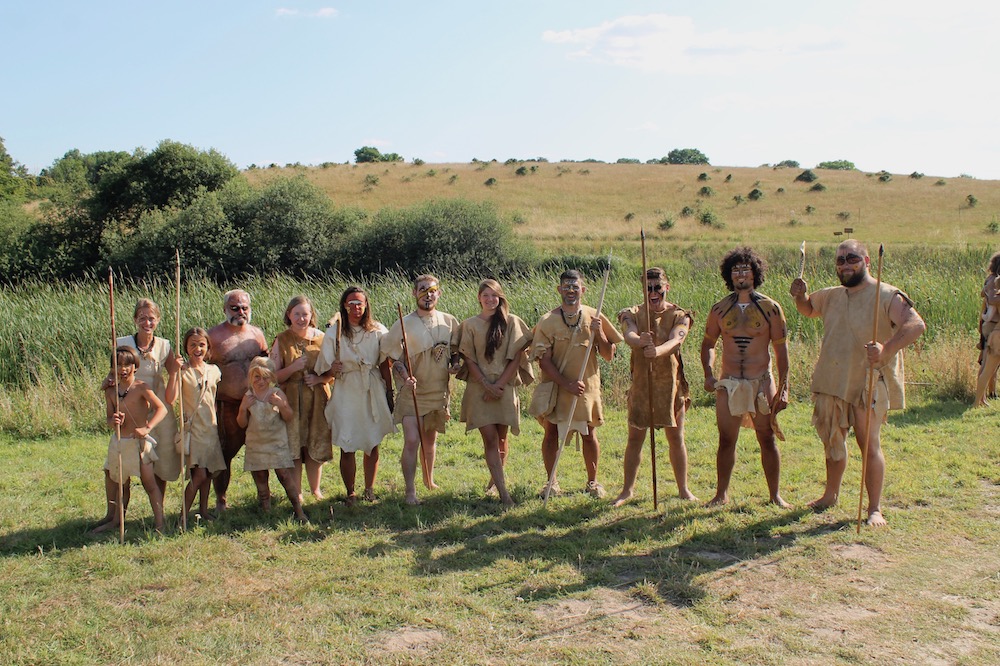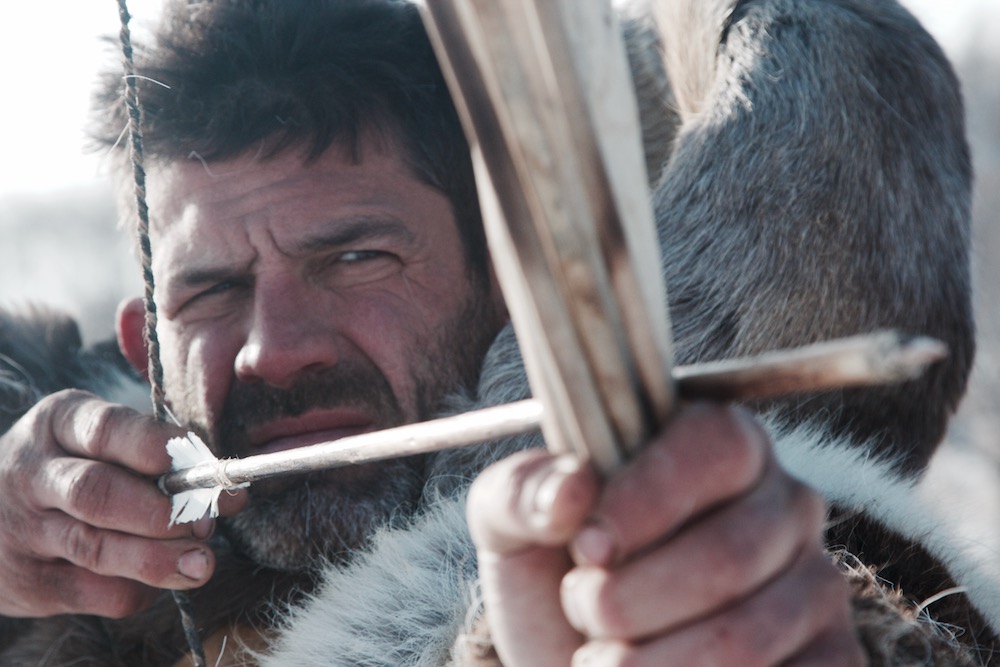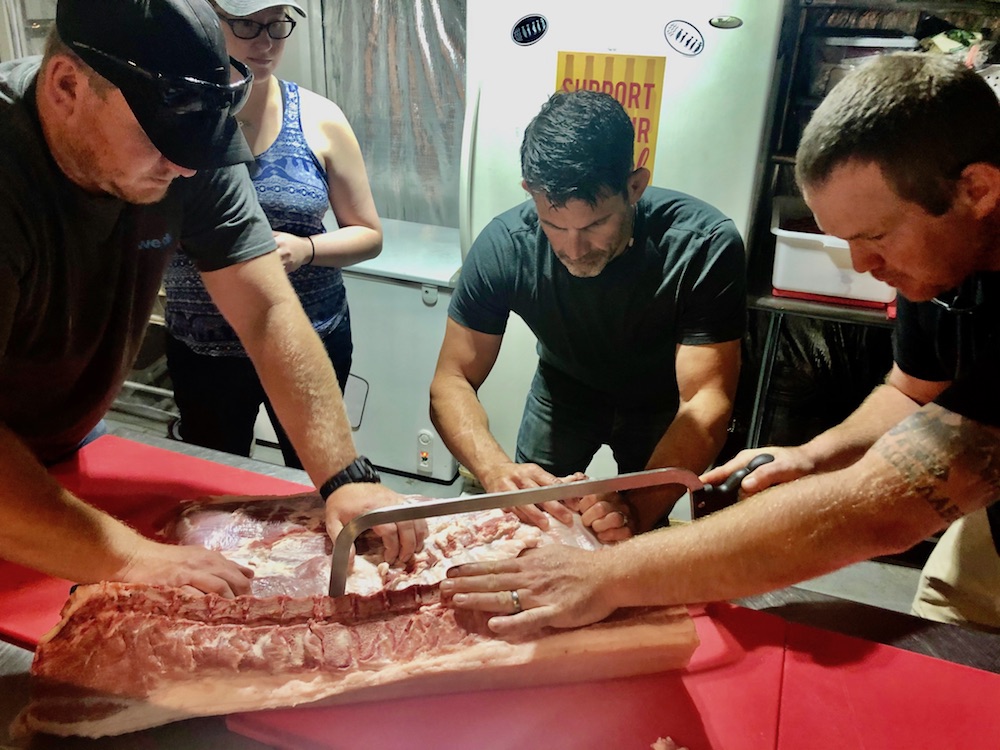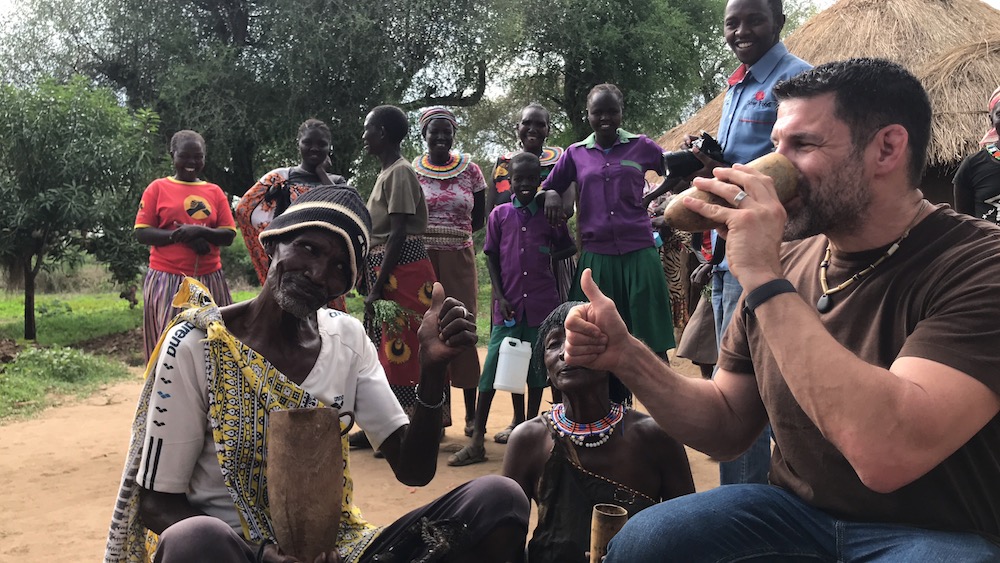Did Processed Foods Make Us Human?
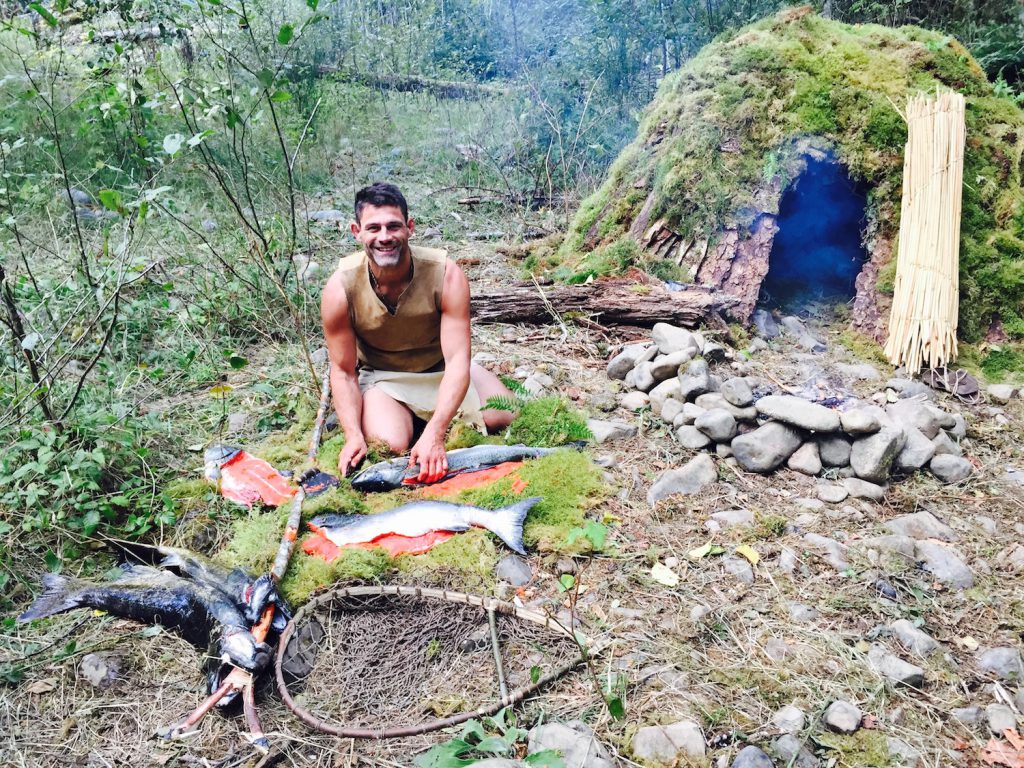
As archaeologist Bill Schindler lay on animal skins in a re-created Mesolithic campsite in Lejre, Denmark, a Viking tattoo artist poked a stone blade into his leg. Schindler had fashioned the flint blade himself, and the artist was using it to apply ink made from pulverized charcoal and Schindler’s wife’s spit.
The tattoo design was based on one found on a 9,600-year-old bone artifact inscribed with figures depicting a man, a woman, two girls, and a boy—the exact makeup of Schindler’s own family.
To make the tattoo more affordable, Schindler had traded it for deerskins that had been scraped with a stone ax and tanned with animal brains. Indeed, the entire Schindler clan was clad in brain-tanned buckskin clothing, sewed with sinew.
They were spending the week as demonstrators at an open-air archaeological museum in Lejre that depicted life in a late Mesolithic culture that ran from about 5300 B.C. to 3950 B.C. The family lived in a thatched hut and foraged for their food. Schindler’s 9-year-old son, Billy, proudly speared a frog for dinner.
Schindler, a professor of archaeology at Washington College in Maryland, had seven students who participated in the museum program. As they watched their teacher getting tattooed, many ground up ochre, charcoal, and chalk to paint patterns on one another’s bodies.
“It was strange but beautiful,” Schindler recalls of the communal body decoration, “and one of the most connected things I’ve ever experienced.” Connection—with our communities, ancient traditions, and especially food—is one of the key themes in Schindler’s work.
Today, he laments, most people in industrialized nations are more disconnected from the plants and animals they eat than humans have ever been. Many people are deeply uncertain about how to choose foods that are nutritious and environmentally friendly. Discussions of diets can be divisive. Obesity and malnutrition are rampant worldwide, and sometimes exist simultaneously in the same individual.
Schindler believes insights from anthropology could help many people make healthier, more sustainable choices. He has studied the food preparation practices of modern hunter-gatherers, traditional agriculturalists, contemporary chefs, and ancient hominins. He stirs them together to create a modern-meets-ancestral approach he calls “eating like a human.”
Schindler teaches this method to students and the public at Washington College’s Eastern Shore Food Lab in Maryland, as well as in virtual cooking courses. And his wife, daughters, and son—his “modern Stone Age family”—are with him every step of the way.
It’s rare that a scientist combines culinary lessons from such broad time periods and widely varying traditions, says Roeland Paardekooper, director of the experimental archaeology organization EXARC, based in Leiden, the Netherlands. “Bill does immersive research where he dives into it and wants to experience the past,” Paardekooper says. “At the same time, he’s trying to make a practical difference … to transform [industrialized] diets and make people connected with their ancestors again.”
Growing up in New Jersey, Schindler spent much of his time hunting, trapping, fishing, foraging, and watching Julia Child cook on TV. “I was very much trying to connect with my food in a visceral and meaningful way,” he says.
But there was a disconnect between his pursuits as an outdoorsman and his typical American diet. For the first half of his life, food was often his enemy. He struggled with his weight as a chubby child, then as a college wrestler, and later as an adult with metabolic syndrome.
Schindler was also plagued by other health problems. During college, a mysterious eye disease left him legally blind and caused him to flunk out and seek work on a pig farm. He later re-enrolled in school and eventually, with the correct diagnosis and care, restored his vision. But it took him 10 years to earn his bachelor’s degree, and he switched majors more than six times.
All the while, his passion for living off the land intensified. He taught himself how to bow hunt, then how to fashion his own bow and arrow. But that wasn’t fulfilling enough. He wanted to hunt deer with the same kind of stone-tipped arrow shot 2,000 years ago by Native Americans in what is now New Jersey. So, he decided to become an experimental archaeologist—an archaeologist who learns about the past in part by re-creating it.
Schindler earned a Ph.D. in anthropology from Temple University in Pennsylvania and studied with archaeologists, anthropologists, and scholars who replicate human technologies from the past. He honed his skills at flint knapping (flaking), fire making, early ceramic techniques, and net making. He thought he’d found his calling. And yet another disconnect was forming—between his profession and his life as a husband and father.
Then one night in 2008, something happened that would unite the various elements in his life. Schindler was flint knapping in the garage when his wife, Christina, interrupted and said, “I need you to come inside.” She asked him to bring his ancient skills into the house in a way that helped his family.
“She was right,” Schindler says. “Why do anything if it’s not going to help the people you love?” But how could stone axes possibly be relevant in 21st-century suburbia?
Eventually, he had a revelation: Almost every technology humanity’s ancestors made involved obtaining, cooking, processing, or storing food. And everything that makes human communities unique—in our cultural and physical evolution—began around 3.3 million years ago with the invention of stone tools. Food, family, and flint knapping are, in fact, connected.
Schindler has devoted himself to investigating the technologies surrounding food, delving into the paleoanthropological record, and experimenting with methods he learned from a variety of Indigenous peoples. One of the key lessons of this research isn’t particularly flattering: Humans, says Schindler, “are one of the weakest species on the planet.” If we were marooned in a wilderness and stripped of our stone and wooden tools, we would die.
Schindler gained a visceral understanding of this lesson when he was in Tanzania in 2015. He and survival expert Cat Bigney were filming National Geographic’s The Great Human Race, a paleoanthropological survivalist show that re-created turning points in human evolution. For this project, Schindler needed to work out how an ancestor species of modern humans, Homo habilis, could have survived 2.4 million years ago.
If we were marooned in a wilderness and stripped of our stone and wooden tools, we would die.
In the first few days, Schindler and Bigney used sticks to dig up tubers and a stone hand ax to hack honey out of a tree. Ravenous and dehydrated, they eventually found the half-devoured carcass of an eland antelope. Working quickly to evade lions, they used a rock to chop off hunks of meat and bash open a bone. Then they clambered up a tree to feast on raw marrow, which Schindler says tastes like a blend of butter and bleeding gums.
The grueling experience gave Schindler a renewed appreciation for food processing and its role in shaping human evolution. Though “processed food” is much maligned in contemporary discussions of healthy diets, food processing actually involves any method of turning raw plants, animals, and fungi into an edible product, including soaking, chopping, and cooking.
Schindler’s focus on food processing leads him to diverge from people who make dietary recommendations based on human physiology alone. Some proponents of various diets point out, for example, that humans lack carnivores’ sharp teeth to rip flesh from bone or great apes’ expansive colons for digesting masses of raw plants. They then conclude that people should not eat certain foods, such as meat or grains.
But in Schindler’s view, “we have no biological business eating almost any food we eat.” Instead, he explains, our ancient ancestors outsourced hunting and digesting prowess to our technologies. As a result, over millions of years, our teeth and guts shrank, and our brains and bodies grew. Our food processing technologies, he contends, propelled the evolution of Homo sapiens. He believes more people should look back to ancestral diets to move forward in healthier and more sustainable ways.
“I am confident that the diet that built us as modern Homo sapiens holds the key to continuing to nourish us today,” Schindler says. The essence of that diet lies not in the ingredients—meat, dairy, grains, fruits, and vegetables—but in how we prepare them. “It’s not about what we eat,” he argues, “so much as it is about how we eat.”
Schindler formulated his views on meat, for example, by looking at shifts in the hominin family tree. Though estimates on the timeline vary, by at least 2.6 million years ago, our ancestors scavenged for meat and marrow, either by chasing off predators mid-meal or by searching for abandoned carcasses. (Schindler suspects humans have gathered food in this way for more than 3 million years.)
Many predators devour their prey’s organs first, so scavenging hominins may have most frequently feasted on muscle meat and marrow, just as Schindler and Bigney did when they stumbled across an eland. But when members of the Homo genus began killing animals, they could access every edible part, including the nutrient-rich organs and blood, Schindler explains.
Anthropologists hotly debate when our ancestors became hunters and cooks, but Schindler sides with scientists who think Homo started hunting and cooking food about 2 million years ago. So, he thinks increases in Homo’s body and brain size at that time came about thanks to nose-to-tail cooking.
Therefore, Schindler thinks modern humans should focus on eating entire animals rather than eating meat. Eating only certain portions of meat, he argues, increases food waste and requires more animals to be slaughtered. Using the entire animal is therefore also more ethical and environmentally sustainable. Schindler also says disposing of many animal parts is a nutritional missed opportunity, as many unpopular cuts are rich in vitamins and minerals.
In the U.S., for example, people may use about 60 percent of cows or 50 percent of sheep by weight. To discover what Americans might be missing, Schindler teamed up with a biologist and butchered 13 whitetail deer. They measured the caloric value of the venison meat, as well as every other edible part of the animal. In their yet-unpublished study, they calculated that the parts of the deer that are often not eaten would provide—depending on an individual’s energy needs—between 13 and 31 days worth of calories.
After that study, Schindler became an offal evangelist, shifting his family’s diet and teaching nose-to-tail butchery to students and the public. His recipes include deviled spleen, stuffed stomach, tallow-fried wings, and blood sausage, in addition to pepperoni and bacon.
Clearly, pepperoni wasn’t on early Homo’s menu. But Schindler embraces modern techniques because “though our biological needs haven’t changed, our cultural needs have. So, in order to create a dietary approach that is accessible, meaningful, and relevant, the food has to look good and taste good.”
Several years ago, Schindler was teaching a class in culinary anthropology when a student raised her hand with a question that crystallized his views on the evolution of food processing. She noticed that when Schindler spoke about ancient technology, he beamed excitedly when talking about food processing. But when Schindler discussed modern food processing, he became angry. What was the difference?
He wrestled with her question for a week before he had a lightbulb moment. He realized that ancient and traditional food processing typically made food digestible and longer lasting while increasing nutrient density and bioavailability, or the amount of nutrients the body can absorb and use. But many modern food processing methods sacrifice nutrients to increase shelf life and profit margins.
Food processing exists on a spectrum, explains Marion Nestle, a professor of nutrition and food studies at New York University. Minimally processed foods, like whole wheat sourdough bread, are prepared in ways that don’t deplete the nutrients. Processed foods—such as homemade bread made with white flour, which is stripped of nutrients and fiber—is usually nutritionally inferior, even when it’s fortified. Ultra-processed foods—think Wonder Bread—are industrially produced, nutrient sparse and calorie dense, and filled with preservatives, colorants, and other synthesized substances. In high-income countries such as the U.S., ultra-processed foods make up more than half of people’s caloric intake.
Based on this spectrum, Nestle agrees with Schindler that emulating the minimally processed methods practiced in many ancestral diets can be beneficial. “To me, modern dietary advice is simple,” she says. “Eat a wide variety of relatively unprocessed foods, emphasize plants, avoid or minimize ultra-processed foods, and balance calories. This sounds a lot like traditional diets, no?”
In Ireland, Schindler had an epiphany about sourdough bread while sticking his hand up a duck.
In Schindler’s view, “We must get back to food processing technologies that make food safe, nutrient dense, and bioavailable.” To seek out these traditional technologies, Schindler visited communities around the world, researching methods for processing everything from grains to dairy to vegetables. He learned how to nixtamalize corn with an alkaline solution to make masa dough in Oaxaca, researched potato detoxification with Indigenous Bolivians, and drank raw milk and blood with pastoralists in Kenya.
In Ireland, he had an epiphany about sourdough bread while sticking his hand up a duck. He’d been studying and lecturing on historic bread baking in the area and was being filmed for a television segment. The host asked him to butcher a duck with a stone tool. When Schindler reached up and pulled out the animal’s innards, he realized that these birds basically make sourdough in their bodies. Their specialized digestive systems—including gizzards—soak, grind, and bacterially ferment whole grains.
For at least 14,000 years, many of our ancestors have done something similar—soaking, grinding, and fermenting grains in stone or clay vessels instead of specialized organs. Just as ancient hominins compensated for a lack of sharp teeth by making sharp axes, our agricultural ancestors overcame an inability to digest many raw grains by inventing beer and sourdough bread.
So, for Schindler, the crucial question is not, Should humans eat bread? The question is, How was the bread processed? Was it processed in a way that makes it less nutritious, with white flour and quick-rising yeast? Or was it processed in a traditional way that enhances nutrition, with whole grain(s) and bacterial fermentation?
Schindler—who describes himself as “passionate about cheese”—has also studied Indigenous communities and traditional agriculturalists who have a long history of consuming dairy. Nearly all of the cultures he’s encountered eat and drink raw, fermented dairy. Humans have been fermenting milk into cheese and other products for at least 7,000 years, and it’s yet another example of food technology mimicking processes found in digestion, he says.
In this case, it’s a phenomenon that happens in baby mammals. If a baby has ever spit up milk on your shoulder, you may have noticed that “it looks like cottage cheese and smells like provolone,” Schindler says. That’s because some infant mammalian stomachs release enzymes such as chymosin (or rennin) that coagulate milk to slow down the digestive process and allow more nutrients to be absorbed.
Similarly, cheesemakers use rennet, which contains rennin, to form cheese curds. And the lactobacillus bacteria that ferments traditional cheeses breaks down lactose and makes the dairy more digestible, even for people who are lactose intolerant. Inspired by these traditions, Schindler frequently drives to Pennsylvania to legally buy raw milk, which he cultures into kefir, cheeses, and fermented butter for his family.
Schindler acknowledges that his dedication is obsessive and often exhausting. Not many researchers live out their studies in the way he does. When Schindler first started making everything from scratch at home, he says, “I learned that I was driving my family incredibly nuts.”
Then several things changed. Schindler got better at cooking and eased up on his strict rules. But mainly, his family became more involved. They all hunt, fish, and forage together. They’ve gotten to know their local farmers and butchers, so they’re in touch with the sources of their food. Schindler’s teenage daughter started a sourdough bread business out of their home. They built a wood-fired oven in the backyard together and enjoy chopping wood to cook sourdough pizzas.
Because in the end, “eating like a human” is not just about connecting with humanity’s ancestors. It’s about that millions-of-years-old tradition of connecting with each other around food.
































